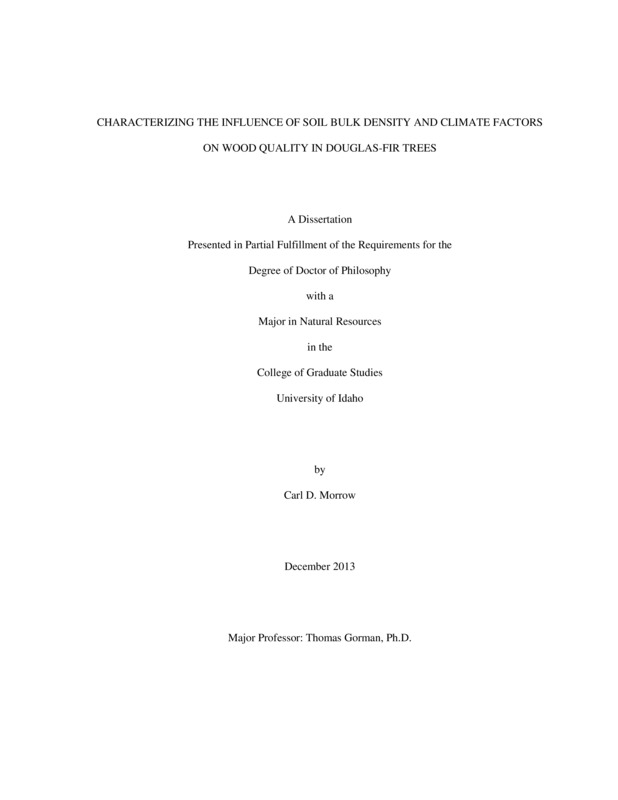Characterizing the influence of soil bulk density and climate factors on wood quality in Douglas-fir trees
Morrow, Carl Daniel. (2013). Characterizing the influence of soil bulk density and climate factors on wood quality in Douglas-fir trees. Theses and Dissertations Collection, University of Idaho Library Digital Collections. https://www.lib.uidaho.edu/digital/etd/items/morrow_idaho_0089d_10061.html
- Title:
- Characterizing the influence of soil bulk density and climate factors on wood quality in Douglas-fir trees
- Author:
- Morrow, Carl Daniel
- Date:
- 2013
- Keywords:
- Douglas-fir latewood percentage MOE Soil bulk density Tracheid anatomy Wood quality
- Program:
- Natural Resources
- Subject Category:
- Wood sciences; Forestry
- Abstract:
-
The percentage of an annual ring composed of high density latewood measured using the threshold latewood demarcation method is commonly reported as a descriptor of both the annual ring formation process and the quality of the wood produced. Recently developed methods have been reported to provide more consistent estimates of latewood in trees exhibiting high intra-ring variability; but there is little published regarding the anatomy at the transition from earlywood (EW) to latewood (LW), and the ability of these alternative methods to predict mechanical properties. These alternative measures of latewood may be more consistent, but without an understanding of the anatomy at the EW-LW transition selected by these alternative methods, the interpretation of the latewood percentages returned by these methods is not meaningful. An assessment of the ability of these alternative latewood measures to predict physical and mechanical properties would further define the value of these alternative latewood measurement methods.
In this paper, we compared the threshold latewood method (TLWP), an inflection based latewood method (ILWP), and a polynomial based latewood method (PLWP) in terms of the region selected as the EW-LW transition, how they measured tree response to environment, and how well they predicted mechanical properties.
We found that in mature suppressed Douglas-fir, ILWP and PWLP were not well correlated with average density (AVGDEN), but that the difference between TLWP and ILWP or PLWP was positively correlated with AVGDEN. Microscopy at the EW-LW transition points showed that the threshold method selected a transition point near Mork's definition of latewood and that the inflection and polynomial methods targeted the region in which the cell wall thickness and lumen diameter changed most rapidly, but exhibited a systematic bias in the location chosen based on AVGDEN.
We studied the differences in TLWP, PLWP, ILWP, and AVGDEN between suppressed Douglas-fir growing on low and high bulk density soils. Analyzing the characteristics of the annual rings over 30 years, we found differences between the groups for all measures that were consistent with the hypothesized difference predicted by the Least Limiting Water Range concept. Trees grown on low bulk density soils had significantly higher AVGDEN and latewood using all measures, but all the measures suggested similar differences.
Finally, we studied the ability of AVGDEN, TLWP, PLWP, and ILWP to predict Modulus of Elasticity (MOE) and Modulus of Rupture (MOR) in small clear samples and the matching high grade 2x4s. We found that AVGDEN and TLWP were better predictors for small clear properties, but PLWP and ILWP had some predictive ability. All measures were better predictors of MOR in the small clears and MOE in the 2x4s. The results of the three studies presented form a basis with which to interpret ILWP and PLWP in the context of both tree response to the environment and the mechanical properties of the wood in Douglas-fir.
- Description:
- doctoral, Ph.D., Natural Resources -- University of Idaho - College of Graduate Studies, 2013
- Major Professor:
- Gorman, Thomas M
- Committee:
- McDonald, Armando G; Shook, Steve R; Coleman, Mark D
- Defense Date:
- 2013
- Identifier:
- Morrow_idaho_0089D_10061
- Type:
- Text
- Format Original:
- Format:
- application/pdf
- Rights:
- In Copyright - Educational Use Permitted. For more information, please contact University of Idaho Library Special Collections and Archives Department at libspec@uidaho.edu.
- Standardized Rights:
- http://rightsstatements.org/vocab/InC-EDU/1.0/

